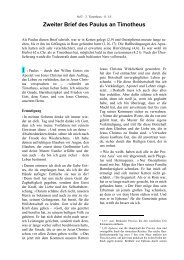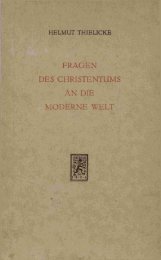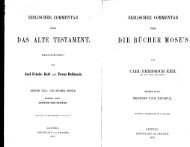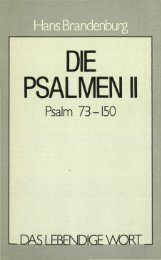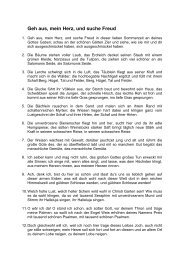You also want an ePaper? Increase the reach of your titles
YUMPU automatically turns print PDFs into web optimized ePapers that Google loves.
The heart beats 70 times per minute, and pumps<br />
about 70 cm 3 of blood into the major circuit at<br />
each contraction. This means that the volume of<br />
blood pumped each minute is about 5 litres (70 x<br />
70 = 4,900 cm 3 ). This is equal to the total volume<br />
of blood in the body. When physically active the<br />
muscles require more blood, so that the pressure<br />
and the flow volume of the blood increases. The<br />
volume per minute can then be raised to 25 litres,<br />
meaning that the entire blood volume is pumped<br />
through the body five times per minute. This is<br />
achieved by a doubling of the stroke volume<br />
from 70 to 140 cm 3 and the rate increases to as<br />
many as 180 beats per minute (140 x 180 =<br />
25,200 cm 3 = 25 litres).<br />
The human heart is morphologically and functionally<br />
a masterpiece of its Creator. The focal<br />
point of circulation, it responds to every demand,<br />
even from the most distant corners of the body.<br />
The larger blood vessels, arteries and veins, are<br />
the main roads carrying the necessary volumes of<br />
blood, but the capillaries provide the actual nourishment.<br />
In this cleverly designed network, the<br />
arteries branch repeatedly and supply the entire<br />
capillary network with blood. These capillaries in<br />
turn combine to form larger and larger veins.<br />
The following table shows that 1,200 million capillaries,<br />
with a total length of 1,200 kilometres,<br />
must be supplied with blood.<br />
Cross-<br />
Total sectional<br />
Type of vessel Number length area Diameter<br />
(m) (cm 2 ) (mm)<br />
Aorta 1 0.4 0.8 10.0<br />
Large arteries 40 8 3 3.0<br />
Arterial branches 600 60 5 1.0<br />
Small art branches 1,800 18 5 0.6<br />
Arterioles 40,000,000 80,000 125 0.02<br />
Capillaries 1,200,000,000 1,200,000 600 0.008<br />
Venules 80,000,000 160,000 570 0.03<br />
Small vein branches 1,800 18 30 1.5<br />
Venous tributaries 600 60 27 2.4<br />
Large veins 40 8 11 6.0<br />
Vena cava (superior and inferior) 2 0.4 1.2 12.5<br />
Table 1: Numerical aspects of human blood vessels.<br />
54<br />
Blood pressure: The pressure against which the<br />
left ventricle must push the blood, is called the<br />
arterial blood pressure. The resulting pressure<br />
waves can be felt as pulses when one touches<br />
the skin over a superficial artery. Arterial pressure<br />
changes continually, varying between a maximum<br />
systolic pressure (full contraction of the<br />
left ventricle) and a diastolic minimum (when the<br />
aortic valve is open). The systolic pressure is normally<br />
about 120 mm (in the old mercury pressure,<br />
which equals 16 kPa 2 ), and the diastolic<br />
about 80 mm (= 10.7 kPa).<br />
The heart of a human embryo already starts<br />
beating at 25 days after conception. Its size is<br />
then only 2.5 mm, while the embryo as such<br />
measures 6 mm. The heart of an adult man<br />
weighs about 320 g and that of a woman 270 g.<br />
It is noteworthy that the strict separation of the<br />
left (arterial) and the right (veinous) sides of the<br />
heart only commences at birth. In the foetus<br />
both atria are connected by the foramen ovale 3 .<br />
The Latin word foetus means begotten; in medical<br />
terms it refers to the embryo at four months<br />
and later.<br />
Did you know that a near-instantaneous “change<br />
of heart” takes place directly after birth? The two<br />
halves of the heart of a foetus operate in parallel.<br />
Both atria and ventricles function together as a<br />
single hollow muscle, and the blood is oxygenated<br />
in the placenta. The lungs require very little<br />
blood, since they do not function, and they are<br />
2<br />
Pressure: The SI unit for pressure is the Pascal (Pa),<br />
named after the French mathematician and physicist<br />
Blaise Pascal (1623 – 1662). 1 Pa = 1 N/m 2 = 1 kg/(ms 2 ).<br />
The previously used unit for air pressure, millimetres<br />
of mercury (mm Hg), was defined as follows in 1954<br />
by the World Organisation for Metrology: “One mm<br />
Hg is the pressure exerted by a 1 mm column of mercury<br />
at a temperature of 0 °C and at a place where<br />
the gravitational acceleration is normal (9.80665<br />
m/s 2 ).” The conversion factors are: 1 mm Hg =<br />
133.332 Pa, 1 kPa = 1,000 Pa. In medicine, the old<br />
unit is used, for historical and practical reasons.<br />
3<br />
Foramen ovale (Latin foramen = hole): The orifice in<br />
the septum between the two atria of a foetus.




